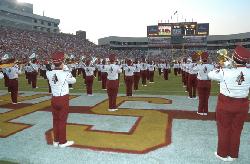
FSU Marching Chiefs
Let festival begin as season opens tonight
By Jim Joanos
That is what FSU football games are, huge celebrations.
They are much more than who wins or loses. The splendor of football players in gold helmets, the precision of that huge marching band, the excitement of a legendary horse and rider thrusting a flaming spear into the turf, and thousands of fans waiving their arms in unison is simply spectacular.
 |
FSU Marching Chiefs |
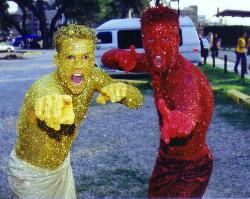 |
Garnet & Gold Guys |
From the opening drum routines to the playing of the Hymn to the Garnet and Gold after the game, there is wonderful music.
Garnet and Gold Glitter boys, cheerleader routines, the War Board, the Fight Song, ladies in Gold hats or patchwork vests and men in garnet golf shirts all add to the splendor. Life in and around the brick walls and towers of our Camelot Castle would even make King Arthur jealous.
The Florida State College for Women, as it was then known, had a marching band as early as the 1930's.
When the school became co-educational in 1947 and its name changed to Florida State University, the band became an integral part of the new football program.
Growth has been constant from a smallish band to the over 400 that comprise one of the largest marching bands in the college world today.
During that first season in 1947, students selected the name, "Seminoles," for all of its athletic teams. The name was chosen to honor the courageous native Americans who in refusing to be removed from their homelands brought the mighty federal army to a standstill. The name has provided an exciting theme upon which so many customs have evolved. For example, following that theme, the band was officially named, "The Marching Chiefs", in 1949.
FSU's "Fight Song" was adopted in 1950, the same season that FSU moved into the new 16,000 seat Doak Campbell Stadium. The words came from a student, Doug Alley, and the music from popular professor Tommie Wright. In 1958, Charlie Carter, created an arrangement for the "Hymn to the Garnet and Gold." It has been a feature of the band's performances since then.
In the late fifties, "Sammy Seminole," a student gymnast dressed as an Indian, did flip-flops the length of the field. Before that two drum majors, Dick Puckett and Ed Franklin, dressed as Indians, and known as the "Flying Seminoles" had entertained the crowds. They were forerunners to "Chief Osceola."
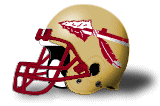 |
FSU Helmet |
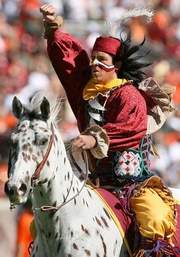 |
Chief Osceola and Renegade |
The spirit and the celebrations increased during the sixties but as elsewhere, slowed down considerably during the Vietnam War years. Bobby Bowden was hired in 1976 and the team's records as well as the school spirit picked up. The team uniforms got fancier. Colorful spear logos were placed on the helmets. Burt Reynolds bought the team some bright golden football pants.
Bill Durham, with the encouragement of Coach and Mrs. Bowden and others, brought Renegade and Osceola into the game day activities. It has been a big hit here throughout the football world.
In 1982, Sports Illustrated proclaimed the Marching Chiefs as the band that never lost a halftime show. During a 1984 game against Auburn, improvising band members began waiving their arms in unison as some strains of music were played over and over. The result was the "warchant." Since 1986, it has been a stadium wide activity.
Success on the field has led to several stadium expansions ultimately resulting in the beautiful gothic structure that exists now.
Since the mid eighties, as a football team, FSU has been among the elite of the college football world. There have been lots of bowl victories and Atlantic Coast Conference championships as well as the two National Championships. However, when it comes to game day traditions and customs they are at the very, very top.
It is festival time again! Do not miss it. See you at the castle.
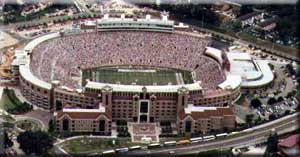 |
Doak Campbell Stadium at Bobby Bowden Field |